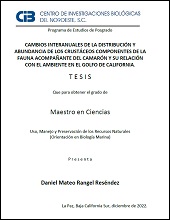| dc.contributor.advisor | López Martínez, Juana | |
| dc.contributor.advisor | García Morales, Ricardo | |
| dc.contributor.author | Rangel Reséndez, Daniel Mateo | |
| dc.date.issued | 2023 | |
| dc.identifier.uri | http://dspace.cibnor.mx:8080/handle/123456789/3153 | |
| dc.description.abstract | La pesca de camarón (PC) es una actividad económica importante en el Golfo de California (GC), aportando divisas y empleos para el Sector Pesquero. Para su desarrollo, se emplean redes de arrastre que capturan incidentalmente otras especies, denominadas fauna de acompañamiento del camarón (FAC), entre ellos, el grupo de los crustáceos es muy numeroso y poco conocido, desconociendo su respuesta a la variabilidad ambiental del GC. Por lo que, se planteó que existe un cambio interanual en la composición, distribución y biomasa de los crustáceos componentes de la FAC, relacionado con el ambiente marino dentro del GC. Para ellos, se emplearon datos procedentes de cruceros prospectivos en la litoral sonorense de GC realizados por el INAPESCA en periodo de veda (julio y agosto) durante 11 años entre 2002 y 2018. Se obtuvo el elenco sistemático, resultando 51 especies en total, de las cuales 8 son nuevos registros para la FAC del Pacifico mexicano. Se determinó la estructura de tallas, la biomasa mediante el método de área barrida, la distribución latitudinal y batimétrica, resultando una relación de ampliación con el fenómeno La Niña, además de incrementos en las tallas, biomasas absolutas, desplazamientos hacia mayores latitudes y a mayores profundidades durante este evento. Observaciones que fueron confirmadas por los modelos de regresión de las relaciones ambiente recurso de variables como temperatura superficial del mar (TSM), concentración de clorofila (Chl-a) y el Índice El Niño Oceánico (ONI), siendo la TSM la variable más importante para todos los aspectos analizados. Por último, se realizó una recopilación sobre las percepciones del sector pesquero de Guaymas que dejan ver una precaria situación de la pesca en México, y como eso podría traer consecuencias a la pesca debido a malas prácticas, así como al propio sector por el abandono en el que se encuentra. | es |
| dc.format | pdf | es |
| dc.language.iso | spa | es |
| dc.publisher | Centro de Investigaciones Biológicas del Noroeste, S.C. | es |
| dc.rights | Acceso abierto | es |
| dc.subject | Golfo de California, captura incidental del camarón, variabilidad ambiental, elenco sistemático, distribución, biomasa | es |
| dc.subject | Gulf of California, shrimp bycatch, environmental variability, systematic cast, distribution, biomass | es |
| dc.title | CAMBIOS INTERANUALES DE LA DISTRIBUCIÓN Y ABUNDANCIA DE LOS CRUSTÁCEOS COMPONENTES DE LA FAUNA ACOMPAÑANTE DEL CAMARÓN Y SU RELACIÓN CON EL AMBIENTE EN EL GOLFO DE CALIFORNIA | es |
| dc.type | masterThesis | es |
| dc.dirtesis.grado | Maestría en Ciencias en el Uso, Manejo y Preservación de los Recursos Naturales | es |
| dc.dirtesis.disciplina | Biología Marina | es |
| dc.dirtesis.universidad | Centro de Investigaciones Biológicas del Noroeste, S.C. | es |
| dc.dirtesis.facultad | Posgrado en Recursos Naturales | es |
| dc.description.abstracten | Shrimp fishing (SF) is an essential economic activity in the Gulf of California (GC), providing foreign exchange and employment for the fishing sector. For its development, trawl nets are used to incidentally capture other species, called shrimp bycatch (SBC), among them, the group of crustaceans is very numerous and little known, and their response to environmental variability in the GC is unknown. Therefore, it was proposed that there is an interannual change in the composition, distribution, and biomass of the crustacean components of the SBC, related to the marine environment within the CG. For this purpose, data from trawls in the Sonoran coast of the CG carried out by INAPESCA during the closed season (July and August) for 11 years between 2002 and 2018 were used. The systematic cast was obtained, resulting in 51 species total, of which 8 are new records for the Mexican Pacific SBC. The size structure, biomass by the swept area method, latitudinal and bathymetric distribution were determined, resulting in a relationship of increase with the La Niña phenomenon, which resulted in increases in sizes, absolute biomasses, displacements to higher latitudes, and greater depths during this event. These observations were confirmed by the regression models of the environmental resource relationships of variables such as sea surface temperature (SST), chlorophyll concentration (Chl-a), and the Oceanic Niño Index (ONI), of which SST was the most crucial variable for all the aspects analyzed. Finally, a compilation, was made on the perceptions of the fishing sector of Guaymas that reveal a precarious situation of fishing in Mexico, and how this could bring consequences to fishing due to bad practices, as well as to the sector it due to abandonment in the one found. | es |

